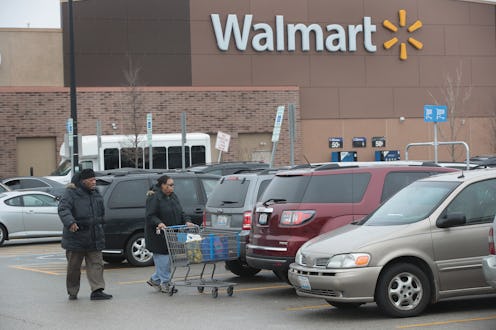News
Why Is There So Much Crime At Walmart?
On Sunday, tragedy struck in Las Vegas when two gunmen killed two police officers and another civilian before turning their weapons on themselves. Officers Alyn Beck, 41, and Igor Soldo, 31, were fatally shot in a CiCi's Pizza before the suspects fled to a neighboring Walmart, where they shot another victim. According to reports, the shooters made their way through the store, leaving terrified customers in their wake and exchanging shots with police officers before taking their own lives.
The senseless violence that met its devastating end in the famous and widespread discount department store is not the first of its kind to play out on Walmart premises. Earlier this year, two men got into an argument at a Walmart service counter in Chandler, Arizona that turned deadly. One man, saying he feared for his life, shot the other, killing him. In 2013, a Greenville, North Carolina Walmart parking lot became the setting for a racially charged crime scene. Lakim Faust, an African-American man, shot four people, targeting white people as his victims. A number of other crimes have also occurred on Walmart sites, including an attempt to sell a baby, the theft of a Girl Scouts cookie cash box, and an attempted sock robbery by a naked man.
When it comes to crime, it seems that Walmart has become a very common denominator. So much of one, in fact, that many community residents have spoken out against the opening of one of the superstores near their homes, often citing economic competition, degradation of small-town businesses, and certainly, a rise in crime.
But why? Walmart, the largest American employer with more than 2.2 million people in their workforce, has always had an unsurprisingly pronounced economic effect on its surrounding areas. But in a recent study published in the British Journal of Criminology, it is not just the local economy that is impacted by Walmart. According to researchers, lower prices also means higher crime rates.
Scott Wolfe, an assistant professor at the University of South Carolina and the lead author of the study entitled "Rolling back prices and raising crime rates? The Wal-Mart effect on crime in the United States," found that in spite of the national plummet in crime during the 1990s, counties that built Walmarts not only missed out on this decline, but in fact saw an increase in crimes. Said Wolfe,
If the corporation built a new store, there were 17 additional property crimes and 2 additional violent crimes for every 10,000 persons in a county.
The reasons for this strange correlation, according to Wolfe and co-author David Pyrooz, assistant professor at Sam Houston State University, are rooted in Walmart's business strategies. Much of the retailer's success lies in location, location, location. And the study suggests that Walmart tends to expand in areas in which residents are less likely to protest their arrival. Community protests of a Walmart arrival generally occur in areas in which residents have high social capital, which is often linked to lower crime rates, better health, and higher income levels.
Pyrooz commented on this relationship, saying,
Counties with more social capital — citizens able and willing to speak up about the best interests of the community — tend to have lower crime rates. Counties with more crime may have less social capital and, therefore, less ability to prevent Wal-Mart from building.
As such, Wolfe noted that Walmart tended to build its stores in "counties with higher than average crime rates" that were "more likely to see Walmart build even after accounting for crime-related predictors, such as poverty, unemployment, immigration, population structure and residential turnover."
But Wolfe and Pyrooz did not find that Walmart was responsible for rising poverty levels, economic disadvantages, or other common markers of crime. Researchers say that more work is needed in order to fully uncover the relationship between Walmart and illegal activity, questions about why criminals might specifically choose the big box store remain unanswered.
J.R. Roberts, a security expert who consults for law enforcement and businesses, conducted an interview with a death-row inmate who kidnapped a woman from a Walmart parking lot and subsequently raped and murdered her. When asked why he chose Walmart as his "hunting ground," the inmate noted that it provided a perfect setting for opportunistic crime, with generally low security (particularly in the parking lot), and a wealth of potential victims. Roberts called it a "24-hour opportunity."
In 1996, then vice-president of Walmart's loss prevention said that 80 percent of Walmart's crime occurred in parking lots. In 1994, the retailer began tests of a parking lot security system that reduced the number of stolen cars from a Tampa, Florida store from 226 to zero. But despite this success, "Walmart parking lots are a virtual magnet for crime," as Justice Starcher of the West Virginia Supreme Court noted. And for the millions of Americans who shop at Walmart, solving this problem is a much higher priority than rollback prices.
